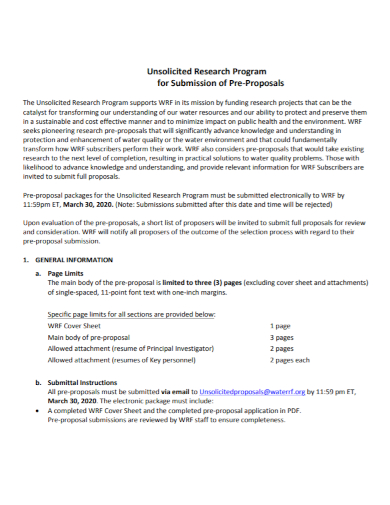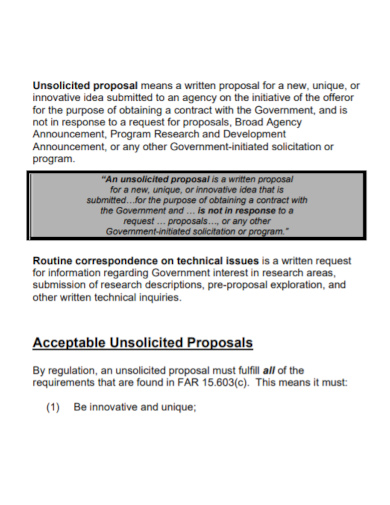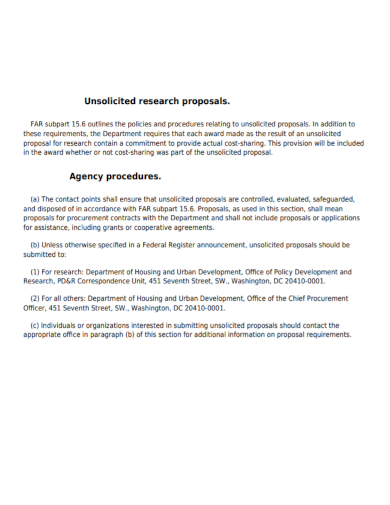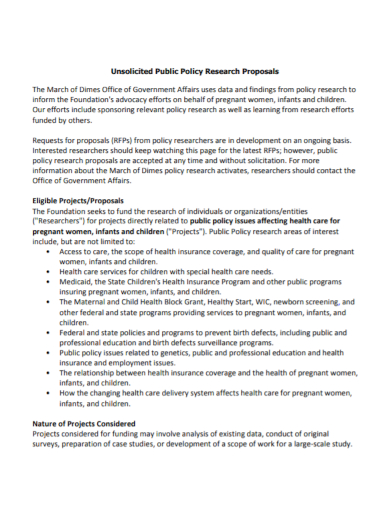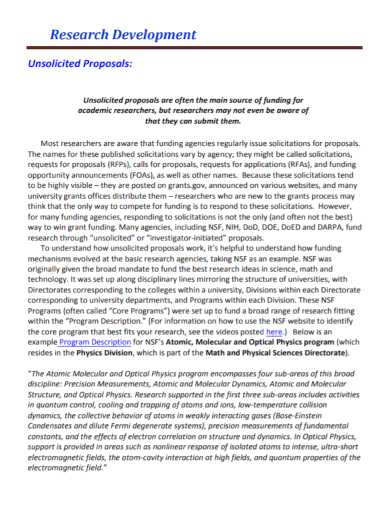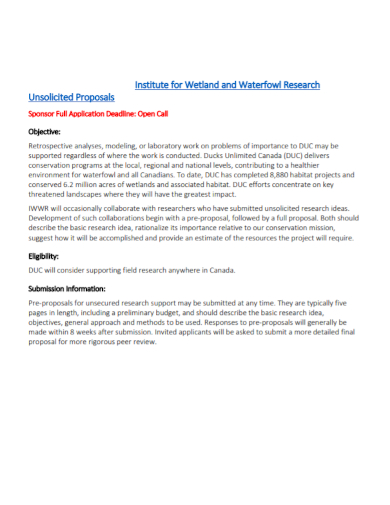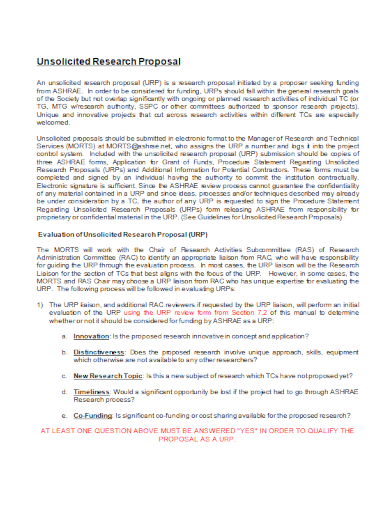Unsolicited researches are projects that are made by private entities to start a public partnership project. The venture is usually spearheaded at the initiative of a private firm or an independent project developer, rather than being a response to a request from the government. It’s sort of a fundraiser, but mainly conducted by private organizations for a development of their own choice. Although unsolicited projects and researches typically refer to efforts that are made to gather money and resources, is can also be used identify and solicit potential investors for additional sources of funding. And since unsolicited researches re conducted by private developers, these contractors often look for potential partners and investors to help support the funding for the development of a project.
Research proposals are documents that let your present the idea and premise of your project to the potential partners and investors that may be interested in your project. The document outline specific components for the study like costs, payments, terms, licenses, academic background, and other details that the board may be requiring from you. It’s overall purpose is to make the panel approve your project so you can finally begin with the development and further research. A well written research proposal can easily help you with what you need. Make sure that your proposal is well written and well written by first checking out these unsolicited research proposal samples that we have listed down for you right below. Once you’ve gotten yourself acquainted with the document, familiar with what it looks like and how it works, feel free to use these samples as guide or maybe even as templates for when you wrote your own research proposal.
8+ Unsolicited Research Proposal Samples
1. Unsolicited Research Submission of Pre-Proposal
2. Unsolicited Research Development Proposal
3. Unsolicited Research Project Proposal
4. Unsolicited Agency Research Proposal
5. Unsolicited Public Policy Research Proposal
6. Unsolicited Research Program for Pre-Proposal
7. Research Development Unsolicited Proposal
8. Research Unsolicited Proposal
9. Unsolicited Evaluation Research Proposal
What Is an Unsolicited Research Proposal?
Unsolicited research proposals, or just any research proposals in general, are documents that outline the topic of the research, identifies the issues that the research will attempt to address, and explains why the issue that you have identified warrants further studies and research. It states the problem and provides a solution to that problem. Research proposals are usually composed of a brief introduction of the topic, the purpose of the study, a literature review highlighting the relevant readings and studies that are related to the topic you’ve chosen, a methodology section, and a bibliography or a list of the references. In other practices, it is common to structure the document into different chapters that define and specify the concepts of the paper, ending with a conclusion that ties al the loose ends of the research together. Essentially, the main purpose of the document is to be able to convince key people and entities to approve the beginning of the study and its development. It also helps identify if conducting the whole research is necessary, and if the panelists like your idea enough just through your presentation. It might evens secure you additional funding and potential sponsorships in the future, if your document is well written.
How To Write an Unsolicited Research Proposal
Try to think of research proposals as elaborate marketing devices used to promote and propose your idea of a research project to a panel so they can green light its development. We want your readers to be convinced enough to approve your study, so it would be best to write the document specific to the project that you are proposing. Not a generalized proposal. Through the document that you will be writing, speak and to them and convince them that their goals and what you want to happen and achieve are aligned. Listed below are the elements of a research proposal that you have to follow.
- Title page
- The title page should contain a short descriptive title of the research, the author of the document, institution or organization, department, name of the research mentor if you have one, and the date of when the document was delivered.
- Abstract
- The abstract is a brief summary of the proposal with not more than 200 words. It should present a brief introduction of the issue, supported by the key statement of the research. It should also contain a summary of how you plan to address this issue that you have identified.
- Table of contents
- The table of contents should be organized following the chronology of the headings and sub-headings that you have used in your document.
- Introduction
- The introduction provides the overall context of your study and should be able to capture the interest of the readers. It should explain the background of your thesis starting from a much broader picture then slowly easing into a specific point of view. The introduction should be written in a level that is easy to understand and comprehend, even by readers of the same educational background such as yourself.
- Thesis statement
- State your thesis statement or sentence in as few words as possible. Clear, straight to the point, and should capture the essence of the study along with its scope and limitations.
- Approach
- Approach talks about the strategies that you will be taking to ensure the success of your venture. It talks about the materials, your procedures, the methods that will be put in place, calculations, etc.
- Preliminary results and discussion
- You should be able to present any preliminary data that you have gathered in your research proposal. And explain how these data fit in the framework of your research.
- Work plan and timetable
- Enumerate the stages of your project in a tabulated format, including the deadlines that you have set for each component. Any work you might have already completed should also reflect in this section.
- Implications of research
- Why is this venture important not just to you but to the environment and the society in general? What new knowledge will this project uncover? These questions and more should be answered.
- List of references
- Don’t forget to always cite the ideas, concepts, texts, and data that you have gathered from related literature and other researches. Basically anything that you do not own, should be listed in the references. It should also follow a uniform and assigned citation format.
FAQs
What is the structure of a thesis?
A thesis is usually composed of an abstract, introduction, literature review, methods, results, discussion, and a conclusion.
What are the 3 main types of proposals?
- Informally solicited
- Unsolicited
- Formally solicited
How long should a research proposal be?
The length of your document varies depending on the scope, scale, and nature of the project. However, it is pretty common for proposal documents to be around 4-7 pages long.
What are some good topics for research?
- Business
- Marketing
- Education
- Architecture
- Management
- Human resources
Drafting a research proposal is no easy task. It can easily dictate the fate of the project that you would want to work on. With the tips and the templates that we have provided above, you should now be more than ready to begin drafting your unsolicited research proposal.
Related Posts
Title Project Proposal Samples [ Community, School, Student ]
FREE 10+ Product Supply Proposal Samples in MS Word | Google Docs | Apple Pages | PDF
FREE 10+ Health Project Proposal Samples [ Public, Mental, Healthcare ]
FREE 11+ Engineering Project Proposal Samples in PDF | MS Word
FREE 4+ Racing Sponsorship Proposal Samples [ Team, Car, Driver ]
FREE 10+ Nursing Project Proposal Samples [ Community, Health, Clinical ]
FREE 11+ Student Council Proposal Samples in PDF | DOC
FREE 10+ Facilities Management Proposal Samples in MS Word | Google Docs | Apple Pages | PDF
FREE 8+ Joint Venture Proposal Samples [ Commercial, Real Estate, Construction ]
FREE 10+ Scholarship Proposal Samples [ Project, Grant, Sponsorship ]
FREE 10+ Computer Purchase Proposal Samples in MS Word | Google Docs | Apple Pages | PDF
FREE 10+ Network Project Proposal Samples [ Design, Security, Bank ]
FREE 14+ Accounting Proposal Samples in PDF | MS Word
FREE 10+ Church Event Proposal Samples in MS Word | Google Docs | Apple Pages | PDF
FREE 10+ History Proposal Samples [ Dissertation, Thesis, Paper ]

